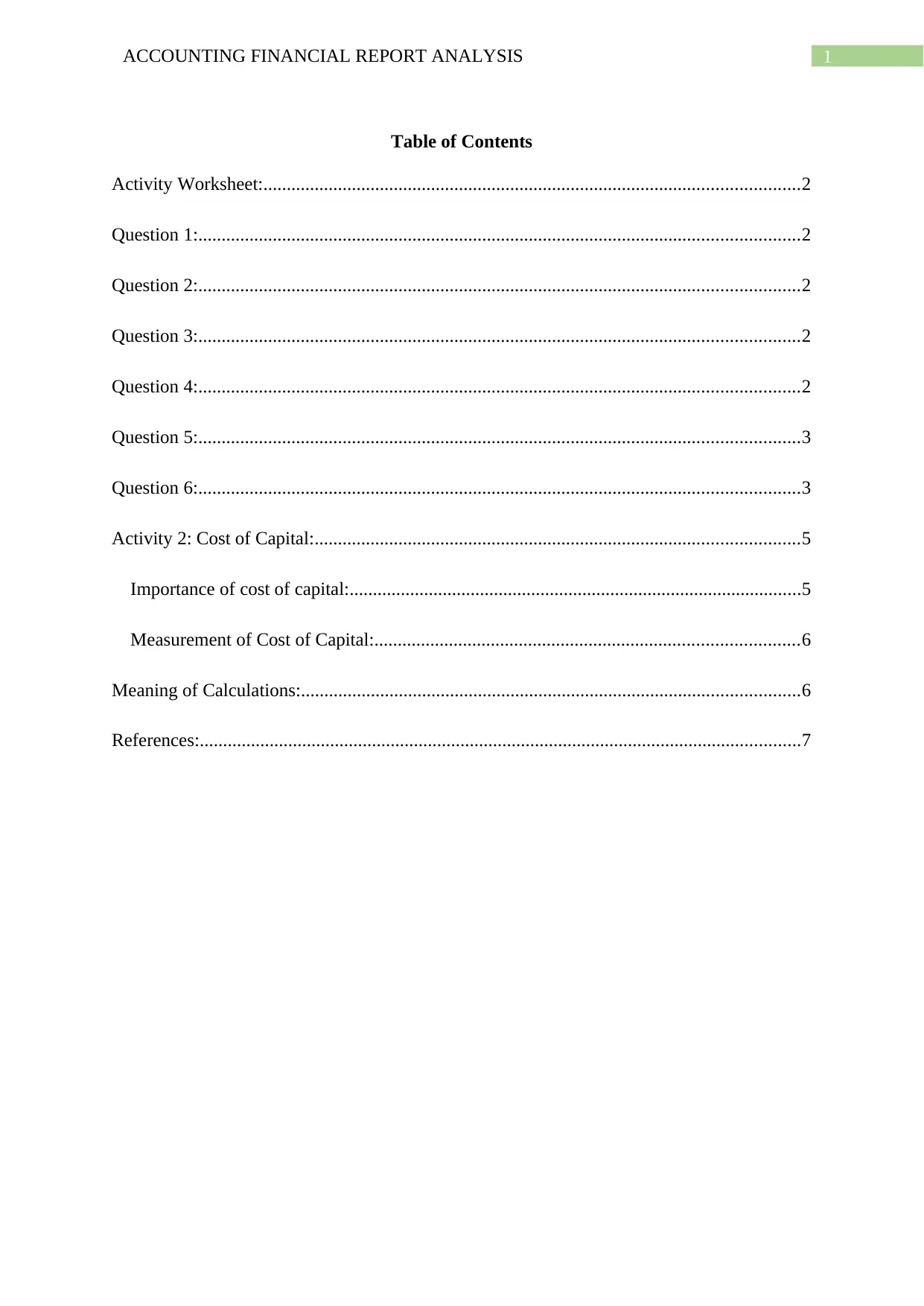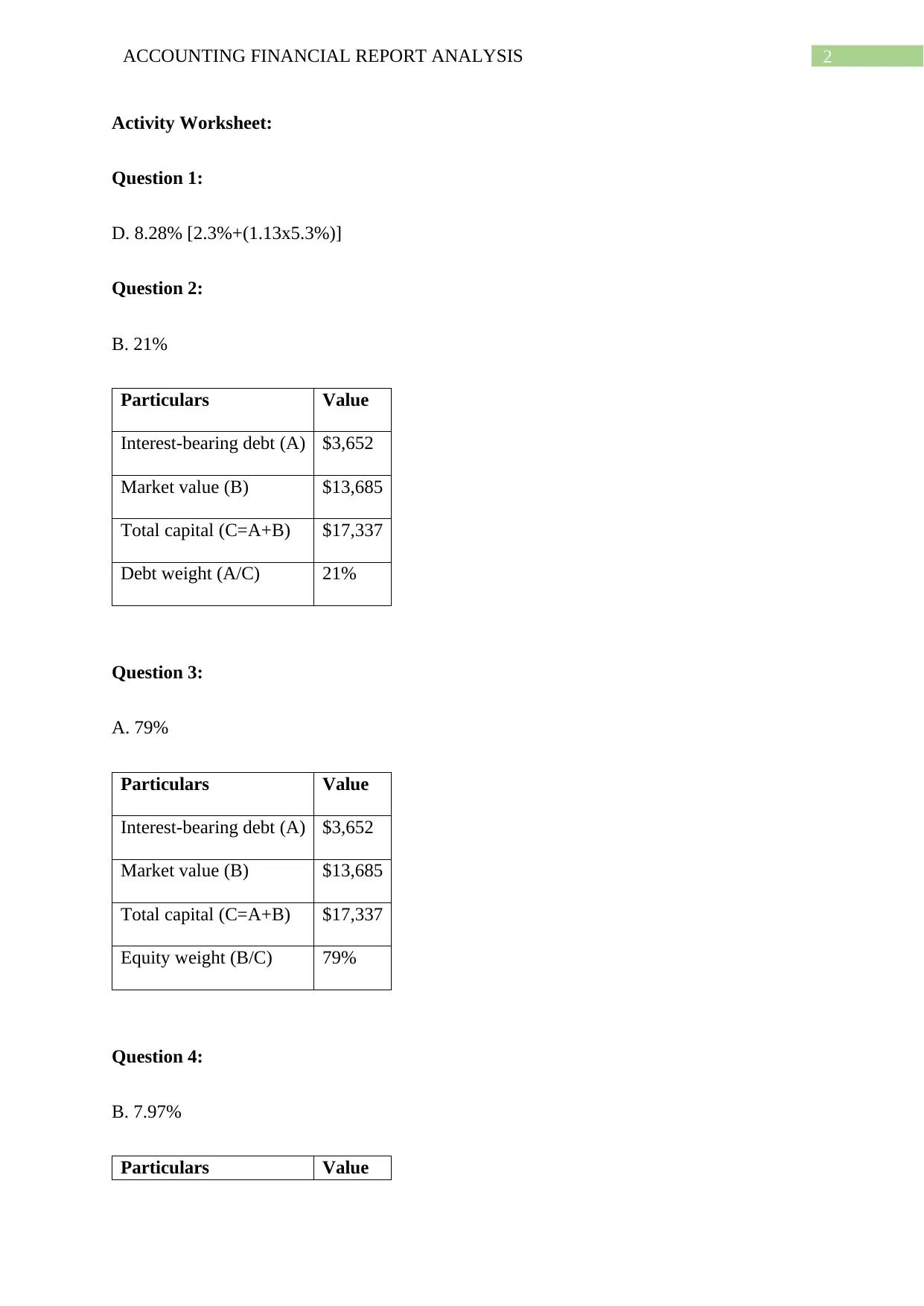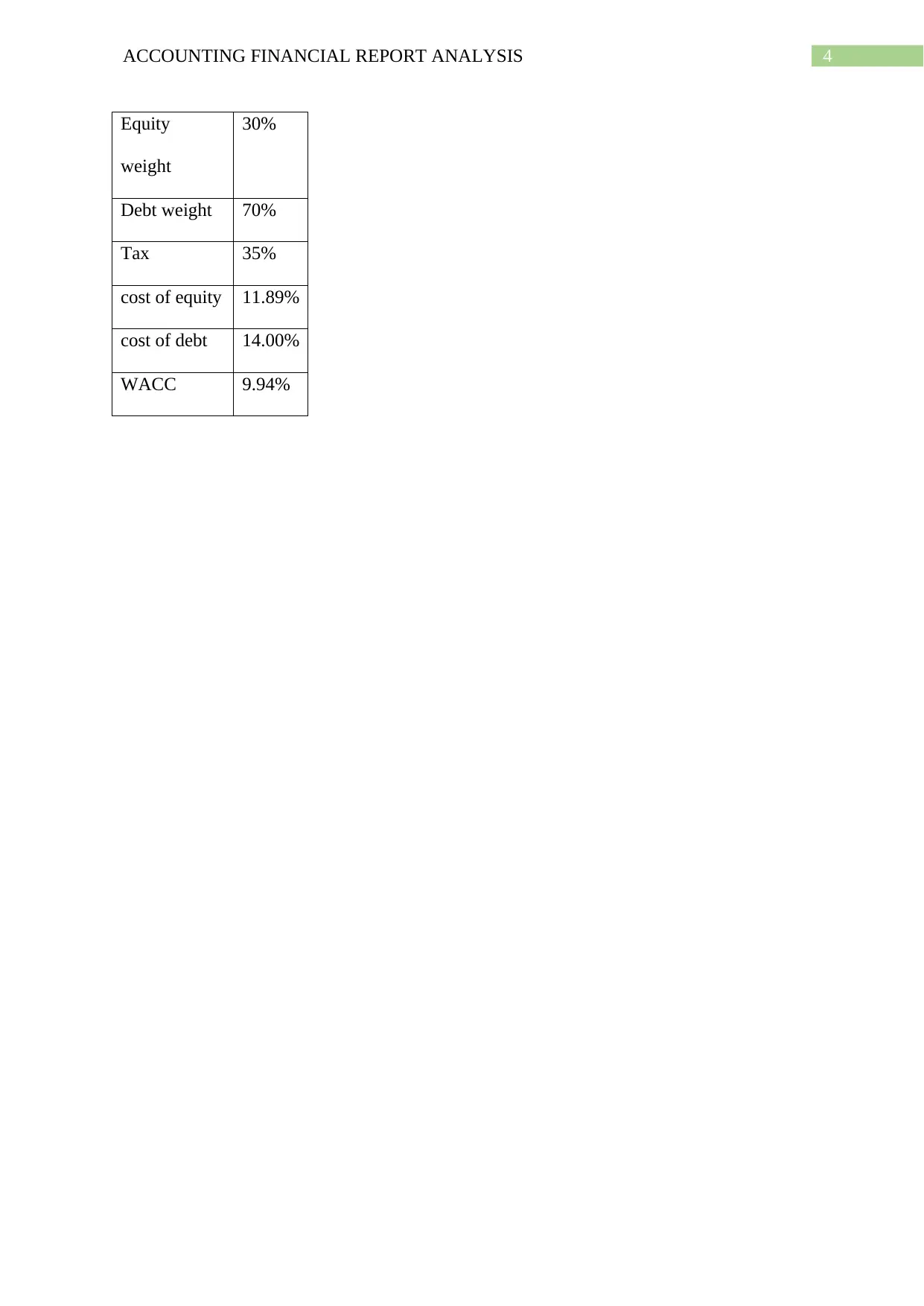Financial Report Analysis and Cost of Capital Calculation
VerifiedAdded on 2022/11/14
|7
|992
|160
Homework Assignment
AI Summary
This assignment solution provides a detailed analysis of financial reports, focusing on the calculation of the cost of capital and the weighted average cost of capital (WACC). The solution addresses several questions related to Zonk Corporation's financial data, including determining the cost of equity, calculating debt and equity weights, and computing the WACC. The assignment also explores the importance of the cost of capital in maximizing firm value, making capital budgeting decisions, and determining capital structure. Furthermore, it explains how to measure the cost of capital for various sources, such as debentures, loans, and equity shares. The solution includes the meaning of the WACC calculations, which incorporates common stock, preferred stock, bonds, and long-term debt. The assignment concludes by discussing the application of the cost of capital as a hurdle rate and discount rate in financial analysis.

Running head: ACCOUNTING FINANCIAL REPORT ANALYSIS
Accounting Financial Report Analysis
Name of the Student
Name of the University
Authors Note
Course ID
Accounting Financial Report Analysis
Name of the Student
Name of the University
Authors Note
Course ID
Paraphrase This Document
Need a fresh take? Get an instant paraphrase of this document with our AI Paraphraser

1ACCOUNTING FINANCIAL REPORT ANALYSIS
Table of Contents
Activity Worksheet:...................................................................................................................2
Question 1:.................................................................................................................................2
Question 2:.................................................................................................................................2
Question 3:.................................................................................................................................2
Question 4:.................................................................................................................................2
Question 5:.................................................................................................................................3
Question 6:.................................................................................................................................3
Activity 2: Cost of Capital:........................................................................................................5
Importance of cost of capital:.................................................................................................5
Measurement of Cost of Capital:...........................................................................................6
Meaning of Calculations:...........................................................................................................6
References:.................................................................................................................................7
Table of Contents
Activity Worksheet:...................................................................................................................2
Question 1:.................................................................................................................................2
Question 2:.................................................................................................................................2
Question 3:.................................................................................................................................2
Question 4:.................................................................................................................................2
Question 5:.................................................................................................................................3
Question 6:.................................................................................................................................3
Activity 2: Cost of Capital:........................................................................................................5
Importance of cost of capital:.................................................................................................5
Measurement of Cost of Capital:...........................................................................................6
Meaning of Calculations:...........................................................................................................6
References:.................................................................................................................................7

2ACCOUNTING FINANCIAL REPORT ANALYSIS
Activity Worksheet:
Question 1:
D. 8.28% [2.3%+(1.13x5.3%)]
Question 2:
B. 21%
Particulars Value
Interest-bearing debt (A) $3,652
Market value (B) $13,685
Total capital (C=A+B) $17,337
Debt weight (A/C) 21%
Question 3:
A. 79%
Particulars Value
Interest-bearing debt (A) $3,652
Market value (B) $13,685
Total capital (C=A+B) $17,337
Equity weight (B/C) 79%
Question 4:
B. 7.97%
Particulars Value
Activity Worksheet:
Question 1:
D. 8.28% [2.3%+(1.13x5.3%)]
Question 2:
B. 21%
Particulars Value
Interest-bearing debt (A) $3,652
Market value (B) $13,685
Total capital (C=A+B) $17,337
Debt weight (A/C) 21%
Question 3:
A. 79%
Particulars Value
Interest-bearing debt (A) $3,652
Market value (B) $13,685
Total capital (C=A+B) $17,337
Equity weight (B/C) 79%
Question 4:
B. 7.97%
Particulars Value
⊘ This is a preview!⊘
Do you want full access?
Subscribe today to unlock all pages.

Trusted by 1+ million students worldwide

3ACCOUNTING FINANCIAL REPORT ANALYSIS
Interest-bearing debt (A) $3,652
Market value (B) $13,685
Total capital (C=A+B) $17,337
Equity weight (B/C) 79%
Debt weight (A/C) 21%
Tax 35%
cost of equity 8.28%
cost of debt 10.50%
WACC 7.97%
Question 5:
A. 4.35
Particulars Value
Equity weight 30%
Debt weight 70%
Tax 35%
Unlevered beta 1.13
Levered market equity beta 4.35
Question 6:
D. 9.94%
Particulars Value
Interest-bearing debt (A) $3,652
Market value (B) $13,685
Total capital (C=A+B) $17,337
Equity weight (B/C) 79%
Debt weight (A/C) 21%
Tax 35%
cost of equity 8.28%
cost of debt 10.50%
WACC 7.97%
Question 5:
A. 4.35
Particulars Value
Equity weight 30%
Debt weight 70%
Tax 35%
Unlevered beta 1.13
Levered market equity beta 4.35
Question 6:
D. 9.94%
Particulars Value
Paraphrase This Document
Need a fresh take? Get an instant paraphrase of this document with our AI Paraphraser

4ACCOUNTING FINANCIAL REPORT ANALYSIS
Equity
weight
30%
Debt weight 70%
Tax 35%
cost of equity 11.89%
cost of debt 14.00%
WACC 9.94%
Equity
weight
30%
Debt weight 70%
Tax 35%
cost of equity 11.89%
cost of debt 14.00%
WACC 9.94%

5ACCOUNTING FINANCIAL REPORT ANALYSIS
Activity 2: Cost of Capital:
Importance of cost of capital:
Cost of capital can be defined as the return that should be received by the firm on
making investment in projects for attracting investors and maintaining the market value
(Frank & Shen, 2016). The importance of cost of capital are stated below;
a. Maximisation of firm value: To maximize the firm value, a firm attempt to reduce
the average cost of capital. This involves judicious mix of debt and equity in capital
structure of an organization to ensure that company does not shoulder unnecessary
financial risk.
b. Capital budgeting decision: Proper estimation of cost of capital is significant for the
company in undertaking decisions relating to capital budgeting (Berger et al., 2018).
Usually the cost of capital is the rate of discount that is used in assessing the
attractiveness of an investment scheme.
c. Administration of working capital: In the administration of working capital the cost
of capital can be employed in computing the cost of carrying the investment in
receivables and assessing the alternative policies relating to receivables.
d. Capital structure determination: The cost of capital creates an influence on the
capital structure of an organization. In planning the optimum capital arrangement that
mainly comprises of debt and equity, adequate importance is given to WACC of an
organization.
e. Evaluating Financial Performance: The idea of cost of capital is valuable in
determining the fiscal performance of higher administration. This is done by relating
the tangible profitability of investment project that is undertaken by the business with
the overall capital cost.
Activity 2: Cost of Capital:
Importance of cost of capital:
Cost of capital can be defined as the return that should be received by the firm on
making investment in projects for attracting investors and maintaining the market value
(Frank & Shen, 2016). The importance of cost of capital are stated below;
a. Maximisation of firm value: To maximize the firm value, a firm attempt to reduce
the average cost of capital. This involves judicious mix of debt and equity in capital
structure of an organization to ensure that company does not shoulder unnecessary
financial risk.
b. Capital budgeting decision: Proper estimation of cost of capital is significant for the
company in undertaking decisions relating to capital budgeting (Berger et al., 2018).
Usually the cost of capital is the rate of discount that is used in assessing the
attractiveness of an investment scheme.
c. Administration of working capital: In the administration of working capital the cost
of capital can be employed in computing the cost of carrying the investment in
receivables and assessing the alternative policies relating to receivables.
d. Capital structure determination: The cost of capital creates an influence on the
capital structure of an organization. In planning the optimum capital arrangement that
mainly comprises of debt and equity, adequate importance is given to WACC of an
organization.
e. Evaluating Financial Performance: The idea of cost of capital is valuable in
determining the fiscal performance of higher administration. This is done by relating
the tangible profitability of investment project that is undertaken by the business with
the overall capital cost.
⊘ This is a preview!⊘
Do you want full access?
Subscribe today to unlock all pages.

Trusted by 1+ million students worldwide

6ACCOUNTING FINANCIAL REPORT ANALYSIS
Measurement of Cost of Capital:
The cost of capital is measured for several sources of capital structure of a business
(Johnstone, 2016). It comprises of cost of debenture, cost related to loan capital, cost of
equity shares, etc. The cost of capital is useful in measuring the cost of debenture such as
terms loans from the financial banks and institutes.
Meaning of Calculations:
The WACC is regarded as the calculation of an organizations cost of capital where
each group of capital is respectively measured. All the sources of capital together with the
common stock, preferred stock bonds and any other types of long term debt which are
included into the WACC computation (Levi & Welch, 2017). An organization’s WACC rises
with the rise in the value of beta and rate of ROE due to the rise in the valuation and growth
in risk.
The computation of company’s cost of capital is in which every category of capital is
weighted respectively. Incorporating every sources of an organization’s capital together with
the common stock, preferred stock, bonds and any other type of long-term debt. The
calculation of cost of capital can be used as hurdle rate as against which organizations and
investors can gauge into the return on invested capital performance. The WACC is generally
used as the discount rate for future cash flow in the analysis of discounted cash flow.
Measurement of Cost of Capital:
The cost of capital is measured for several sources of capital structure of a business
(Johnstone, 2016). It comprises of cost of debenture, cost related to loan capital, cost of
equity shares, etc. The cost of capital is useful in measuring the cost of debenture such as
terms loans from the financial banks and institutes.
Meaning of Calculations:
The WACC is regarded as the calculation of an organizations cost of capital where
each group of capital is respectively measured. All the sources of capital together with the
common stock, preferred stock bonds and any other types of long term debt which are
included into the WACC computation (Levi & Welch, 2017). An organization’s WACC rises
with the rise in the value of beta and rate of ROE due to the rise in the valuation and growth
in risk.
The computation of company’s cost of capital is in which every category of capital is
weighted respectively. Incorporating every sources of an organization’s capital together with
the common stock, preferred stock, bonds and any other type of long-term debt. The
calculation of cost of capital can be used as hurdle rate as against which organizations and
investors can gauge into the return on invested capital performance. The WACC is generally
used as the discount rate for future cash flow in the analysis of discounted cash flow.
1 out of 7
Related Documents
Your All-in-One AI-Powered Toolkit for Academic Success.
+13062052269
info@desklib.com
Available 24*7 on WhatsApp / Email
![[object Object]](/_next/static/media/star-bottom.7253800d.svg)
Unlock your academic potential
Copyright © 2020–2025 A2Z Services. All Rights Reserved. Developed and managed by ZUCOL.





